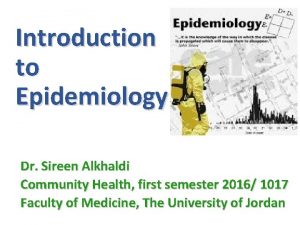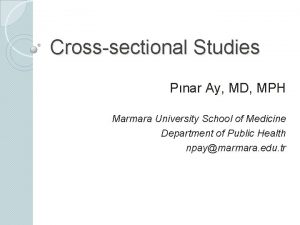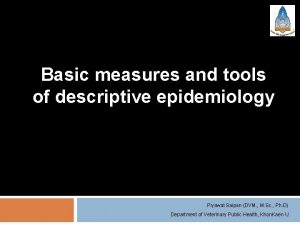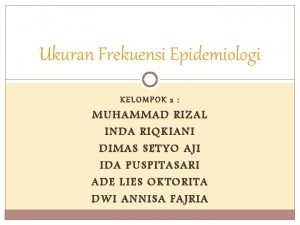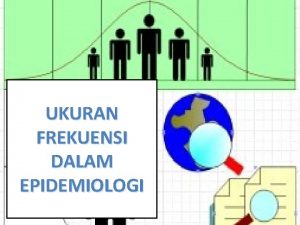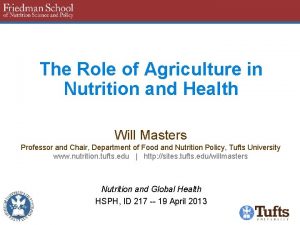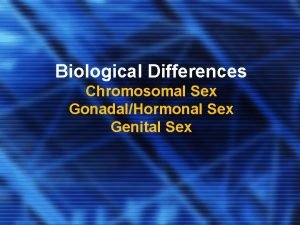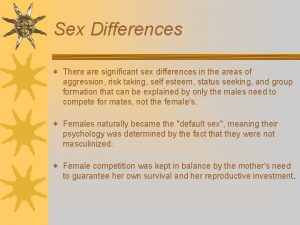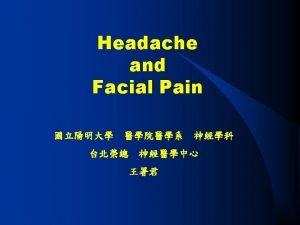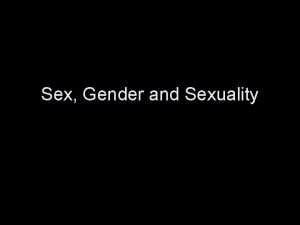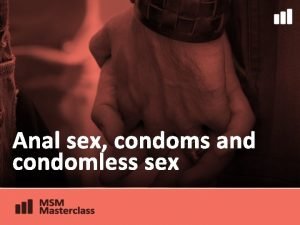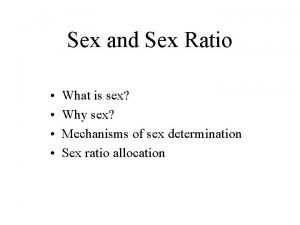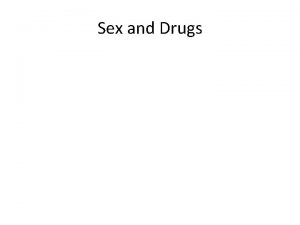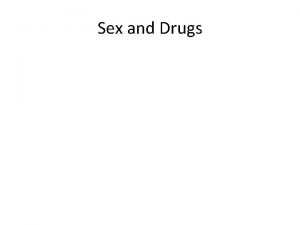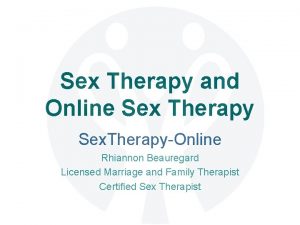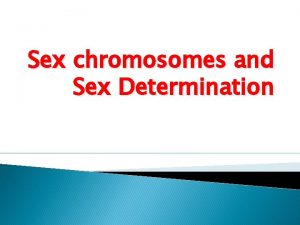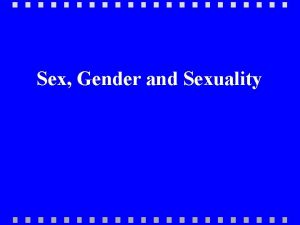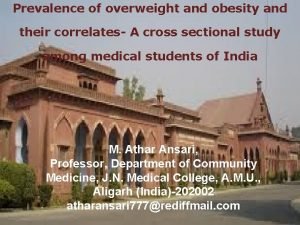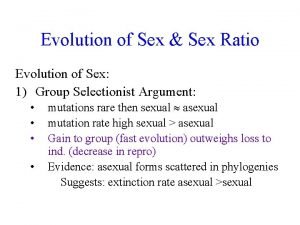Sex Differences in the Prevalence and Correlates of


















- Slides: 18

Sex Differences in the Prevalence and Correlates of Colorectal Cancer Testing: 2002 -2003 Health Information National Trends Survey Sally W. Vernon 1, Amy Mc. Queen 1, Helen I. Meissner 2, Carrie N. Klabunde 3, William Rakowski 4 Division of Health Promotion & Behavioral Sciences, Center for Health Promotion and Prevention Research, University of Texas - Houston, School of Public Health, Houston, Texas. 2 Division of Cancer Control and Population Sciences, Behavioral Research Program, Applied Cancer Screening Research Branch, National Cancer Institute, Bethesda, Maryland. 3 Division of Cancer Control and Population Sciences, Applied Research Program, Health Services & Economics Branch, National Cancer Institute, Bethesda, Maryland. 4 Department of Community Health, Brown University, Providence, Rhode Island. 1

Study Rationale • Rates of current CRC test use among both males and females fall below desired levels (<50%). • NHIS 2000 reported somewhat greater endoscopy test use among men. • There is scant data that examine correlates of CRC testing stratified by sex.

Positive Correlates of CRC Test Use Females • • Family history of CRC Annual medical check-up MD recommendation Previous mammogram Older Non-White Overweight Vitamin supplement use Males • • • Family history of CRC Annual medical check-up MD recommendation Previous PSA test College educated Physically active High perceived risk for CRC Personal history of any cancer Not fatalistic about cure

Research Questions 1. What is the prevalence of FOBT, endoscopy, or any CRC test use? How do these rates differ by sex? and How do these results compare with findings from other national surveys? 2. What are the significant correlates of FOBT, endoscopy, or any CRC test use? and How does the pattern of correlates differ by sex?

Sample Characteristics 6369 A surveys completed by adults 18 years of age and over 2734 participants (43%) were 50 years old or older 2689 had no personal history of colon or rectal cancers 63% were female 74% were non-Hispanic White

Fecal Occult Blood Test (FOBT) HINTS Protocol • Description of FOBT was read • Have you ever heard of a fecal occult or stool blood test? (yes/no) • Have you ever done a stool blood test using a home test kit? (yes/no) • When did you do your most recent stool blood test using a home kit to check for colon cancer? – – A year ago or less More than 1 but not more than 2 years ago More than 2 but not more than 5 years ago Over 5 years ago

Endoscopy HINTS Protocol • Have you ever heard of a sigmoidoscopy or a colonoscopy? (yes/no) • Description of sigmoidoscopy/colonoscopy is read • Have you ever had… – a sigmoidoscopy? (yes/no) – a colonoscopy? (yes/no) • When did you have your most recent {sigmoidoscopy/(or) colonoscopy} to check for colon cancer? – – A year ago or less More than 1 but not more than 5 years ago More than 5 but not more than 10 years ago Over 10 years ago

CRC Test Use Prevalence: HINTS 2002 -2003 Males Females Sample Size n = 999 Weighted % Sample Size n = 1687 Weighted % 619 61. 5% 1137 66. 5% FOBT within past year 55 5. 2% 146 9. 4% Endoscopy within 10 years 303 31. 4% 524 31. 1% Both FOBT & Endoscopy 143 13. 4% 218 11. 7% Either FOBT or Endoscopy 511 50. 9% 902 53. 3% Lifetime use “ever had” FOBT or Endoscopy Current use

Independent Variables Measured in the HINTS & NHIS • Demographics: – – – Age Race/ethnicity Marital status Education Income • Health History & Status: – – – Insurance status Regular physician Number of physician visits in the past year Weight Personal history of cancer Family history of cancer • Health Behaviors: – – fruit & vegetable intake weekly exercise, enough to sweat smoking status prostate-specific antigen (PSA) test in past year or mammogram in past 2 years

Independent Variables Measured in the HINTS • Cancer Information Seeking – – Looked for cancer information from any source (self, other) Confidence in being able to get advice or information about cancer if needed Trust in sources of cancer information* Attention paid to information about health or medical topics in the media* • Cancer Knowledge – – – Age to start regular CRC testing CRC test-specific intervals High risk age group for developing CRC • Cancer Beliefs – – – – – Perceived risk (absolute, comparative) Cancer worry Arranging a CRC test is easy Afraid to find CRC if tested Regular CRC testing increases chances of finding cancer when it’s easy to treat CRC testing is too expensive Everything causes cancer There’s not much people can do to lower their chances of getting cancer So many different recommendations about preventing cancer, it’s hard to know which ones to follow * Multiple items used to create scale scores

Data Analysis • Logistic regression analyses were conducted in SUDAAN to account for the sampling strategy and all results reflect weighted data. • A 2 -step procedure was used. First, demographic, health history & status, and health behavior variables were analyzed in a multivariate logistic model and correlates significant at P <. 05 were included with the HINTS variables in the second model. • This procedure was repeated for each dependent variable, stratified by gender.

Positive Correlates of CRC Test Use Results of Step 1 Multivariate Analysis Females Males • More physician visits. E • More physician visits. F, E • Mammogram in past 2 • PSA in past year. F, E years. F, E • College graduate. E • Older age (≥ 65 years)F, E • Non-Hispanic. E • Exercising weekly. E • Fruit & vegetable intake ≥ 5/day. F F = FOBT; E = Endoscopy

Positive Correlates of CRC Test Use Results of Step 2 Multivariate Analysis Females • • • More physician visits. E Mammogram in past 2 years. F, E More attention to health topics in the media. F Knowledge of CRC test-specific interval. F, E Arranging CRC testing is easy. E CRC testing is not too expensive. F CRC testing is too expensive. E Distrust in cancer information sources. F, E More perceived comparative risk for CRC E Afraid to find CRC if tested. E CRC testing leads to early detection. F Males • • • More physician visits. E PSA in past year. F, E More attention to health topics in the media. F Knowledge of CRC test-specific interval. F, E Arranging CRC testing is easy. F CRC testing is too expensive. F, E • • • Older age (≥ 65 years)F, E Fruit & vegetable intake ≥ 5/day. F Cancer information seeking other E • F = FOBT; E = Endoscopy

Correlates of CRC Test Use Comparing NHIS 2000 & HINTS Step 1 NHIS 2000 • • • Gender. F, E Non-Hispanic. E Older age. F, E More education. F, E More physician visits. F, E Mammogram within 2 years. F, E More physical activity. F, E Married. F, E Usual source of care. F, E Personal history of cancer. E Family history of CRC or any cancer. E • Former smoker. F, never smoker. F, E HINTS Step 1 • • Not applicable Males, Non-Hispanic. E Males, Older age. F, E Females, College education. E More physician visits. E Recent cancer screening. F, E Males, Exercising weekly. E • Males, Fruit & vegetable intake ≥ 5/day. F F = FOBT; E = Endoscopy

Correlates of CRC Test Use HINTS Step 2 • HINTS provided new correlates of CRC test use: – – – – – Information seeking by other Distrust in cancer information sources More attention to health topics in the media Knowledge of CRC test-specific interval Higher perceived comparative risk for CRC Arranging a CRC test is easy Afraid to find CRC if tested Belief that CRC testing finds CRC when it’s easier to treat Belief that CRC testing is not too expensive

Correlates of CRC Test Use HINTS Step 2 • Variables expected to be associated with CRC test use, but were not statistically significant using HINTS data included: – Absolute perceived risk – Cancer worry – Cancer information seeking for self – Fatalistic beliefs (can’t do much to reduce risk, too many different recommendations, everything causes cancer)

Comparison of Prevalence Estimates Current adherence NHIS 2000 HINTS 2002 -3 FOBT – males 16. 8% 5. 2% FOBT – females 17. 5% 9. 4% Endoscopy – males 37. 4% 31. 4% Endoscopy – females 31. 1% Any test – males 44. 5% 50. 9% Any test – females 41. 0% 53. 3%

Conclusions • Current CRC test use is still very low in both men and women • Correlates of test use show some sex-specific differences – Beliefs/attitudes are associated with test use for women but not for men – Other health behaviors are associated with test use for men but not for women
 Period prevalence vs point prevalence
Period prevalence vs point prevalence Percentage defination
Percentage defination Period prevalence vs point prevalence
Period prevalence vs point prevalence Period prevalence vs point prevalence
Period prevalence vs point prevalence Kurt bumby
Kurt bumby Sex in the greenhouse
Sex in the greenhouse Xxtesticles
Xxtesticles Sex sex sex
Sex sex sex Sex sex sex
Sex sex sex Correlates of effective schools
Correlates of effective schools Punnett square for sex linked traits
Punnett square for sex linked traits Advanced higher biology unit 2
Advanced higher biology unit 2 Sex determination and sex linkage
Sex determination and sex linkage Once a sex offender always a sex offender
Once a sex offender always a sex offender Prevalence calculation formula
Prevalence calculation formula Descriptive vs analytic epidemiology examples
Descriptive vs analytic epidemiology examples Frekuensi epidemiologi adalah
Frekuensi epidemiologi adalah Point prevalence rate adalah
Point prevalence rate adalah Obesity prevalence europe
Obesity prevalence europe
